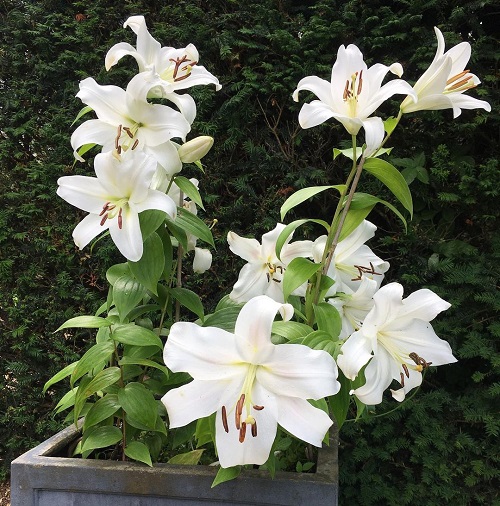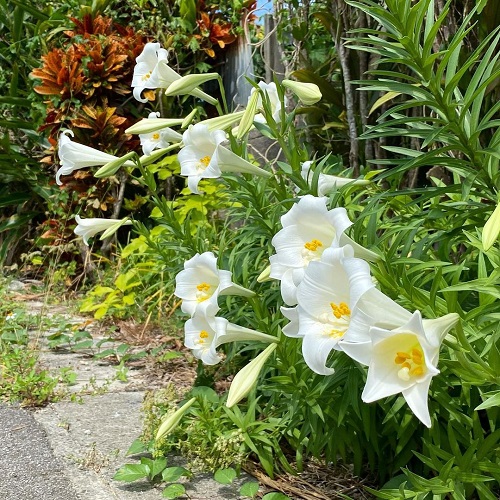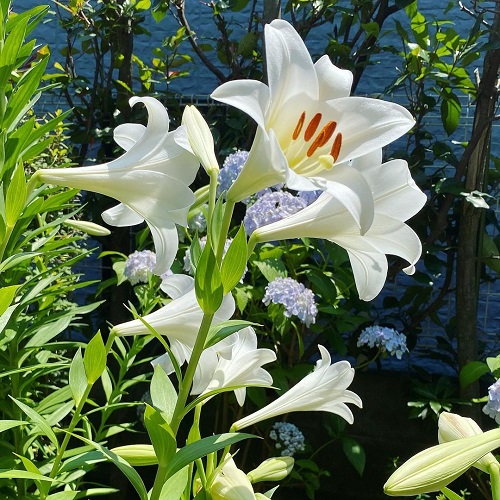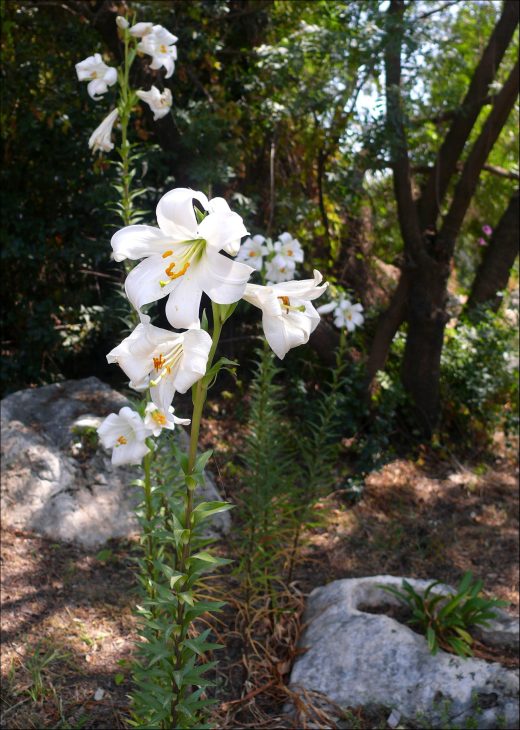Lilium Candidum – an exotic flower with large white blooms that you must grow if you love refreshing fragrance!
Discover all the tips and tricks to grow the timeless flower – Lilium candidum, commonly known as the Madonna Lily and enjoy its intoxicating fragrance in your garden!
USDA Zones: 5-9
Read the Stargazer Lily Meaning, Colors, and Symbolism here
Madonna Lily Information
Madonna Lily (Lilium Candidum) belongs to the Liliaceae family and is from the Mediterranean region.
Origin and Historical Significance
- Geographical Roots: Lilium candidum is native to the Eastern Mediterranean region, extending into Western Asia.
- Historical Context: It is one of the oldest cultivated lilies, often associated with biblical and medieval symbolism.
- Cultural Importance: Lilium candidum is commonly linked to purity and motherhood and is frequently depicted in religious and historical art.
- Associations with Hera: The Madonna Lily was often linked to Hera, the queen of the Greek gods and goddesses. According to myth, it was said to have sprung from milk droplets spilled from Hera’s breast as she nursed her son, Hercules.
- Wedding Rituals: In Greek weddings, the Madonna Lily played a prominent role. Brides would often carry bouquets of these lilies, symbolizing purity, innocence, and the hope for a fruitful marriage.
Appearance and Characteristics
- Height and Structure: Lilium candidum can grow up to 3 to 6 feet tall, with sturdy stems that bear a cluster of flowers.
- Leaves: The leaves are lance-shaped, bright green, and appear in whorls along the stem.
- Flowers: The bloom features stunning trumpet-shaped, pure white flowers that can measure up to 3-5 inches across.
- Fragrance: One of its most distinctive features is its sweet, heady aroma, particularly noticeable during the evening.
Black Dragon Snake Plant Care and Growing Guide
Propagating Madonna Lily
By Division (Easiest Method).
- The best time to divide Madonna Lily bulbs is in late summer or early autumn when the plant is dormant.
- Gently dig up the mature Lilium candidum plant, being careful not to damage the bulbs.
- Carefully separate the bulbs from each other. You may need to use your hands or a garden fork to do this. Each bulb should have a portion of roots attached.
- Choose a new planting site with well-draining soil and adequate sunlight. Lilium candidum prefers full sun to partial shade.
- Dig holes for each bulb at a depth of about 4 to 6 inches and space them apart according to the desired arrangement. Place each bulb with the roots down and the growing tip facing upward.
- Water the newly planted Lilium candidum bulbs thoroughly and apply a layer of mulch to help retain moisture and regulate soil temperature.
- Lilium candidum should start growing in the following spring. Maintain regular watering and provide proper care as they establish themselves.
Philodendron Sharoniae Care and Growing Guide
Taking Bulbs Out in Cold Climate
- In regions with cold winters, it’s a common practice to lift Lilium Candidum bulbs before the first frost. This is typically done in the fall after the foliage has naturally withered and turned yellow – a sign of dormancy. Use a garden fork to gently dig up the bulbs, taking care not to damage them.
- After lifting the bulbs, allow them to air-dry for a few days to cure. Then, store them in a cool, dry place to protect them from freezing temperatures during the winter. A basement or garage can be suitable storage locations. Use a breathable container like a mesh bag or paper bag to store the bulbs.
Note: In regions with mild winters, you can leave the bulbs in the ground year-round. Lilium Candidum bulbs are generally hardy and can tolerate mild frosts.
Gulf Stream Nandina Care and Growing Guide
Best Pot Size for Growing Madonna Lily

For growing Lilium candidum in a pot, choose a container at least 8-10 inches in diameter – it will support the plant’s growth for 2-3 years, post which, you can then re-pot it into a one size bigger pot than the old one.
Check Ultimate Peace Lily Fertilizers to Boost Growth here
Requirements for Growing Madonna Lily

Light
Plant your Lilium candidum in a spot that receives at least 6 to 8 hours of direct sunlight each day. More sunlight generally leads to more blooms.
If possible, plant in an area where the lily will receive morning sunlight and partial afternoon shade. The intense heat of late afternoon sun can sometimes be too harsh, especially if you live in a hot climate.
Soil
Madonna Lily prefers well-draining, fertile soil with a slightly acidic to neutral pH of around 6.0 to 7.0. The best mix you can use is:
- 2 parts Coir or Peat Moss
- 1 part Perlite
- 1 part Compost
- 1/2 part Bone Meal
Alocasia Wentii Care and Growing Guide
Water
Water Lilium candidum moderately, aiming to keep the soil consistently moist but not soggy. Always water at the base of the plant, avoiding wetting the foliage.
Follow the trick of watering the plant when the topsoil goes a little dry.
Temperature and Humidity
Lilium candidum grows well in temperatures between 65-90°F (18-32°C). It prefers a moderate climate. Humidity levels of about 40-50% works the best for the plant.
Avoid extreme temperature fluctuations and drafty areas, as this can stress the plant. So, choose a spot that’s safe from such issues.
Read Peace Lily Brown Tips here
Madonna Lily Care
Fertilizer
Fertilize Lilium candidum with a balanced liquid fertilizer like 10-10-10 or 5-10-10, once in 3-4 weeks, after diluting it to 1/2 of its strength. Some of the best options are:
- Osmocote Flower & Vegetable Smart-Release Plant Food: This formula is rich in essential nutrients, providing a balanced diet for your Madonna Lilies.
- Miracle-Gro Water Soluble Bloom Booster: Specifically designed to promote larger and more abundant blooms, it contains a higher concentration of phosphorus.
- Espoma Bulb-tone: Organic and specifically formulated for bulbs and tubers, including lilies.
Best and Cheap Homemade Fertilizer Options
1. Banana Peels
- Rich in Potassium: Helps in flower production.
- Application: Dry and grind the peels into a powder and sprinkle it around the base of the plant.
2. Coffee Grounds
- Acidic pH: Suitable for Lilium candidum which prefers slightly acidic to neutral soil.
- Application: Mix the used coffee grounds with soil or sprinkle them around the plant.
3. Eggshells
- Calcium Boost: Provides necessary calcium for cellular development in plants.
- Application: Crush the eggshells and sprinkle them around the soil.
4. Fish Tank Water
- Rich in Nutrients: The water from a freshwater aquarium is rich in nitrogen and other nutrients.
- Application: Use the fish tank water to irrigate the plants.
Check out Philodendron Green Princess Care and Growing Guide here
Pruning
Trim spent blossoms to encourage new growth and prevent seed formation. Remove dead or yellowing leaves and stems at their base. It helps maintain plant health and appearance, but avoid excessive pruning to ensure future blooms.
Pests:
Aphids: These small insects may infest the plant, usually on the undersides of leaves. Use insecticidal soap or a strong spray of water to remove them.
Diseases:
- Botrytis Blight: This fungal disease can cause brown spots on leaves and stems, especially in humid conditions. Remove affected parts and improve air circulation.
- Gray Mold: Another fungal issue is gray mold can develop in damp conditions. Proper watering practices and good air circulation help prevent it.
- Lily Mosaic Virus: This viral disease can cause mottled or streaked leaves. Infected plants should be removed to prevent spreading.
Check Out Different Types of Pink Lily Varieties here
How to Display Lilium Candidum in the Gardens
1. Mass Planting
Create a stunning focal point by planting a mass of Madonna Lilies in a dedicated garden bed. The uniform white blooms will create a striking contrast with green foliage.
2. Mixed Borders
Combine Lilium Candidum with other perennial plants like lavender, roses, or delphiniums to create a diverse and colorful garden border.
3. Container Gardening
Plant Madonna Lilies in large pots or containers on your patio or deck. This allows you to move them around for different displays.
4. Underplanting
Use Madonna Lilies as underplanting beneath taller shrubs or trees. Their height and elegant blooms make them ideal for filling in the lower layers of your garden.
5. Formal Gardens
Incorporate Madonna Lilies into formal garden designs, such as knot gardens or parterres. Their regal appearance complements the structured layout of these gardens.
6. Mixed Colors
While Madonna Lilies are typically white, you can introduce variety by planting them alongside other lily varieties in different colors. This creates a vibrant and diverse display.
Check Out Philodendron Tortum Care and Growing Guide here
Lilium Candidum Toxicity
The plant is not toxic to humans but it can be to pets.
- Cats: Lilium candidum is highly toxic to cats. Ingesting even small amounts can lead to severe kidney failure.
- Dogs: While not as toxic to dogs as they are to cats, consumption can still result in mild gastrointestinal upset.
Signs of Poisoning in Pets
- Vomiting
- Diarrhea
- Loss of appetite
- Lethargy
- Acute kidney failure (in cats)





